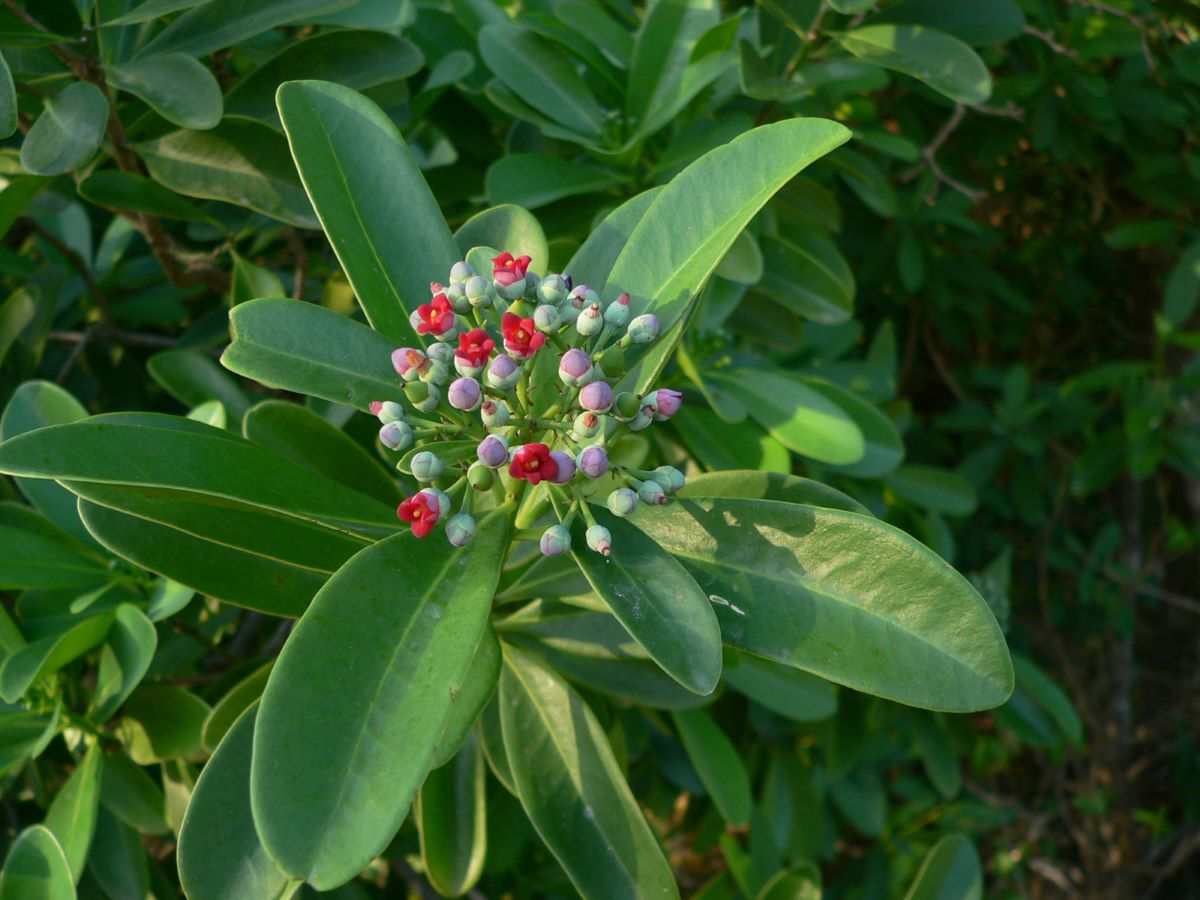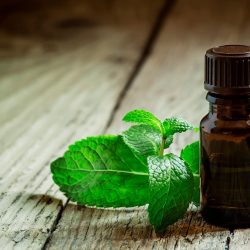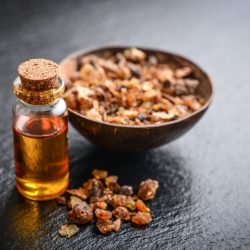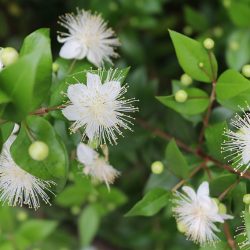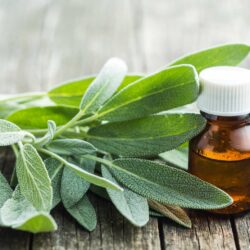“Saro” is an English abbreviation of Mandravasarotra, which means“he who destroys evil or overcomes all trials” in Malagasy. It is also found in Madagascar under the name of ” fanalamangidy “.
Saro essential oil, extracted from an ancient plant, is attracting growing interest in the world of phytotherapy and aromatherapy. This oil, with its many virtues, comes from a plant endemic to Madagascar, known scientifically as Cinnamosma fragrans. This article takes an in-depth look at the little-known facets of this essential oil, from its history to its modern applications.
Latin name:
- Cinnamosma fragrans
Botanical family:
- Canellaceae
Producing organ:
- Leaves, branches
Extraction of Saro essential oil
Extracting Saro essential oil is a meticulous process designed to preserve all its beneficial properties.
How is Saro essential oil extracted?
Saro essential oil is obtained by steam distillation of the plant’s leaves. This traditional method is widely used to extract essential oils, as it preserves the integrity of the plant’s volatile and active components. During the distillation process, steam passes through the Saro leaves, releasing their essential oils. This mixture of steam and oil is then cooled, leading to the separation of the water and oil, and the purified Saro essential oil is recovered.
This process not only preserves the active components of the oil, but also ensures that its therapeutic properties remain intact. This is a delicate technique that requires precise control of temperature and pressure to ensure the quality of the extracted oil.
What are the characteristics of saro essential oil?
Saro oil has several outstanding characteristics:
- Colour: It has a light yellow colour, which is typical of essential oils extracted by steam distillation.
- Fragrance: Its fragrance is fresh and camphorated, reminiscent of the smell of eucalyptus, making it pleasant to use in aromatherapy.
- Composition: Saro oil is rich in compounds such as 1,8-cineole (also known as eucalyptol) and limonene. 1,8-cineole is renowned for its antiseptic and expectorant properties, while limonene offers anti-inflammatory and antioxidant benefits.
These characteristics make Saro essential oil a popular product not only in traditional medicine, but also in modern aromatherapy and other therapeutic applications. Its unique composition makes it an effective natural remedy for a variety of ailments and contributes to general well-being.
A little history
Saro is an ancient plant that has been around since the age of the dinosaurs. As an essential oil with a bright future, it’s important to emphasise the age of this species, which is endemic to Madagascar and is found in Africa, but only in fossil form. As such, it is an archaic plant with an ancient and versatile local Madagascan culture, comparable to Ravintsara.
Saro is still the plant most widely used by the natives of the Red Island. In the Sakalava region, saro is called by various names, indicating its daily importance for the local inhabitants: “fire in the bowels”, “which removes bitterness”, “ginger wood” or “chilli wood”, referring to saro’s fiery flavour. Traditionally, saro was considered a tonic and anti-poison. With its warm, flowery fragrance, saro essential oil is a must-have in aromatherapy, especially for preventing everyday ailments.
saro” is the English name, a contraction of Mandravasarotra, which in Malagasy means “that which annihilates evil or overcomes all trials”. It is also known as“fanalamangidy” in Malagasy.
Saro is an archaic plant that existed as far back as the time of the dinosaurs.
In terms of a brand new essential oil (with a very bright future), it is nevertheless important to point out the archaic nature of this species endemic to Madagascar, which has certainly been found in Africa, but only as a fossil!
It is therefore an archaic plant, grown locally in Madagascar for centuries, with widely developed uses comparable to those of Ravintsara.
Native to Madagascar, this evergreen, highly aromatic tree can grow up to 5 m tall. Unique in the world, this plant grows in several varieties depending on the region.
It is found mainly in the north and west of the island, colonising sands at altitudes of between 0 and 800 metres. It is the plant most used by the populations of the west of the island.
Even today, saro is the plant most used by the populations of the west of the Red Island. In the Sakalava region, saro is referred to by a number of expressions that show just how important it is to the local population on a daily basis: “fire in the bowels”, “that removes bitterness”, “ginger wood” or “chilli wood” all refer to saro’s fiery flavour. Traditionally, saro is considered a tonic and anti-poison. Saro essential oil, with its warm, flowery fragrance, is a must-have in aromatherapy, particularly useful for warding off everyday ailments.
Widely used in their traditional pharmacopoeia, Mandravasarotra has powerful antibacterial and antiviral properties. As well as its medicinal virtues, the Madagascans believe that saro has magical powers, using it to ward off spells and during shamanic ceremonies.
The saro is said to be used during traditional fights between men (Tolona) and during tests of strength against oxen (tolon’omby) by the Tanala tribe. Boiled with “soafotsy” leaves, saro leaves make a traditional tea. Wrestlers drink the decoction before the fight.
What are the pharmacological properties of the essential oil of Saro twigs and leaves?
Here is a table summarising the properties of Saro essential oil:
| Property | Molecules involved | Effects and applications |
|---|---|---|
| Antiviral ( ) | β-pinene, 1,8-cineole (eucalyptol) | Acts against viruses, including herpes, by blocking their development and spread. |
| Expectorant, Anticatarrhal ( ) | 1,8-cineole (eucalyptol) | Stimulates the glands of the respiratory mucosa, liquefies and helps expel secretions from the respiratory tract. |
| Neurotonic ( ) | Various components of the oil | Restores tone to the nervous system, promoting balance without excessive excitation. |
| Antibacterial ( ) | Various components | Effective against bacteria causing urinary tract, lung and intestinal infections and other germs such as staphylococci. |
| Astringent ( ) | Specific components of the oil | Helps tighten skin pores, contributing to a smoother, firmer appearance. |
| Anti-inflammatory | Anti-inflammatory compounds | Reduces inflammation and soothes irritated or inflamed areas. |
| Anti-oxidant | Natural antioxidants | Protects against damage caused by free radicals, supporting skin and body health. |
| Spasmolytic | Spasmolytic agents | Helps relieve muscle spasms and tension. |
This table provides a clear overview of the main and secondary properties of Saro essential oil, highlighting its active components and their specific beneficial effects.
Anti-infectious effects :
Saro essential oil is a powerful anti-infective against Staphylococcus aureus, Escherichia coli, Salmonella typhi, Pseudomonas aeruginosa, Neissseria gonorrhoeae, Gardnerella vaginalis, Listeria sp., Streptococcus sp., Shigella sp., Pasteurella sp . and Candida albicans.
It is also antiviral, making it an excellent complement to preventive or curative antibiotic therapy against HPV. Saro is also antifungal and antiparasitic.
Effects on immunity :
As an immunostimulant and immunomodulator, saro essential oil is particularly effective in preventing viral or bacterial winter infections.
Respiratory effect :
Renowned for its respiratory properties, saro is an antiseptic, expectorant and bronchial fluidifier.
Soothing and spasmolytic effects :
Calming for the nervous system and antispasmodic, saro essential oil is in fact a major musculotrope and neurotrope; generating a certain neuro-sedation.
Repellent effect :
Toxic to mosquitoes, saro effectively repels Aedes aegypti; the agent of yellow fever.
Other effects:
- Neurotonic
- Skin astringent
- Analgesic and intestinal analgesic
- Anti-inflammatory
- Cortison-like
- Mucolytic
- Healing
How do I use Saro essential oil in my beauty routine?
Thanks to its unique properties, Saro essential oil has a special place in beauty routines, particularly for its beneficial effects on the skin.
Saro essential oil is particularly appreciated for its astringent action on the skin. This property makes it ideal for improving the appearance of mature, wrinkled skin, as well as for treating stretch marks and scars. Its astringent action helps to tighten skin tissue, contributing to firmer, smoother skin.
Practical uses
- For stretch marks and scars:
- Saro essential oil can be effectively used to reduce the appearance of stretch marks and scarred areas. To do this, we recommend diluting it 2% in a vegetable oil of your choice. This dilution is important to avoid skin irritation.
- How to use:
- Once the mixture is ready, apply it locally to the areas concerned. Use gentle rubbing movements or circular massages to help the oil penetrate the skin. This method of application stimulates blood circulation in the treated area, which can improve the skin’s elasticity and texture.
Synergies with other essential oils
To reinforce the astringent action of Saro essential oil, it can be combined with other essential oils with complementary properties. For example:
- Rose Geranium Essential Oil:
- This oil is renowned for its regenerating and firming properties. In synergy with Saro oil, it can increase the effectiveness of the treatment on mature skin and scars.
Practical information
For optimal use in your beauty routine, here are a few tips:
- Dilution: Always dilute Saro essential oil before applying it to the skin. A 2% dilution is generally sufficient and safe.
- Choice of carrier oil: Choose a vegetable oil suited to your skin type. Oils such as sweet almond oil or jojoba oil are excellent choices for most skin types.
- Frequency of application: Apply your mixture once or twice a day, depending on the sensitivity of your skin.
By incorporating Saro essential oil into your beauty routine in this way, you can benefit from its unique properties to improve the appearance and health of your skin.
Does Saro essential oil require any precautions for use?
- Do not use in combination with cortisone, as there is a risk of drug interaction
- Do not use over a prolonged period, as there is a risk of resting the pituitary-adrenal axis and suffering acute adrenal insufficiency if you stop taking the essential oil
- Avoid applying the essential oil in the evening (or before any period of rest)
- Not recommended for people suffering from osteoporosis, due to the inherent risk of decalcification
- Dermocaustic in its pure state, dilution required
- Beware of possible gynaecomastitising effects with prolonged use. Linalool inhibits the production of testosterone, to be avoided over the long term in males as an endocrine disrupter
- For adults only
- Caution in cases of renal insufficiency per os (nephrotoxicity)
- Do not diffuse, inhale or use in the bath
- Not recommended for asthmatics and/or epileptics
- Not recommended for pregnant or breast-feeding women
- Do not use on animals
Medical literature and clinical trials:
- Roger Randrianarivelo, Samira Sarter, Eric Odoux, Pierre Brat, Marc Lebrun, Bernard Romestand, Chantal Menut, Hanitriniaina Sahondra Andrianoelisoa, Marson Raherimandimby, Pascal Danthu. Composition and antimicrobial car activity of essential oils of Cinnamosma fragrans. Food Car Chemistry, 2009
- Randrianarivelo R, Danthu P, Benoit Car., Ruez P, Raherimandimby M, Sarter S. Novel alternative to antibiotics in shrimp hatchery: effects of the essential oil of Cinnamosma fragrans on survival and bacterial concentration of Penaeus monodon larvae. J Appl Car Microbiol. 2010
- Olivier Behra, Pascal Danthu, Samira Sarter, Rina Radaniela, Cesar Fourcade, Roger Randrianarivelo, Boris Ranaivosoa, and Bérengère Arnal-Schnebelen. Saro (Cinnamosma fragrans Baillon) essential oil: Application in car Health and Medicine. African Natural Plant Products: New Discoveries and Challenges in car Chemistry and Quality, 2010
- Harinantenaina, L., Asakawa, Y., & De Clercq, E. (2007). Cinnamacrins A- C, Cinnafragrin D, and Cytostatic Metabolites with α-Glucosidase Inhibitory Activity from Cinnamosma macro car pa. Journal of natural products
- M Pidoux, H. Harilalarisoa, R. Iharilanto, D. Andriambolona-Voahangy. Prevention of superficial postoperative infections and healing of lesions using a mixture of Saro and Calophyllum inophyllum oils: the case of circumcisions in Madagas car. 2012
- Inocente, E. A., Shaya, M., Acosta, N., Car P., Rakotondraibe, L. H., & Piermarini, P. M. (2018). A natural agonist of mosquito TRPA1 from the medicinal plant Cinnamosma fragrans that is toxic, antifeedant, and repellent to the yellow fever mosquito Aedes aegypti. PLoS neglected tropical car diseases

